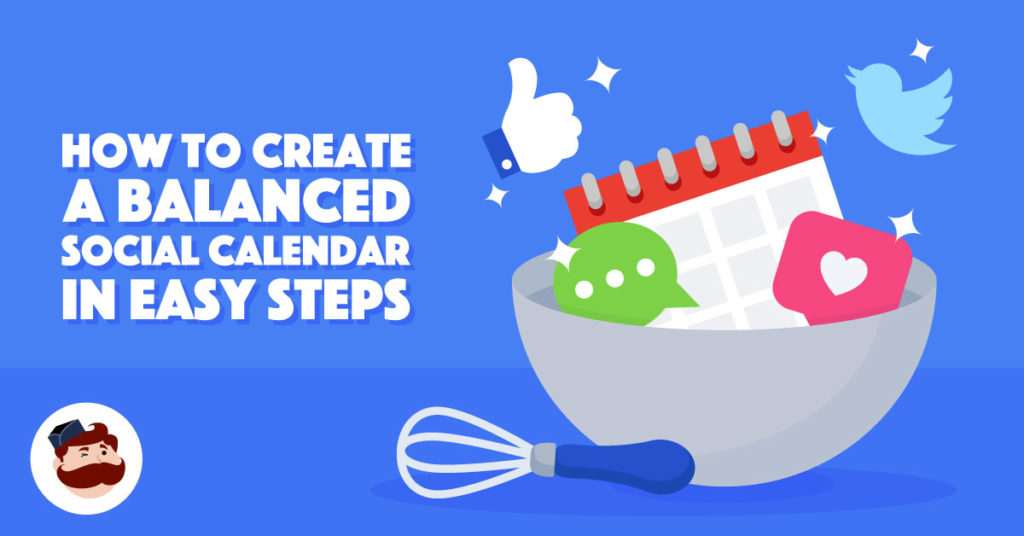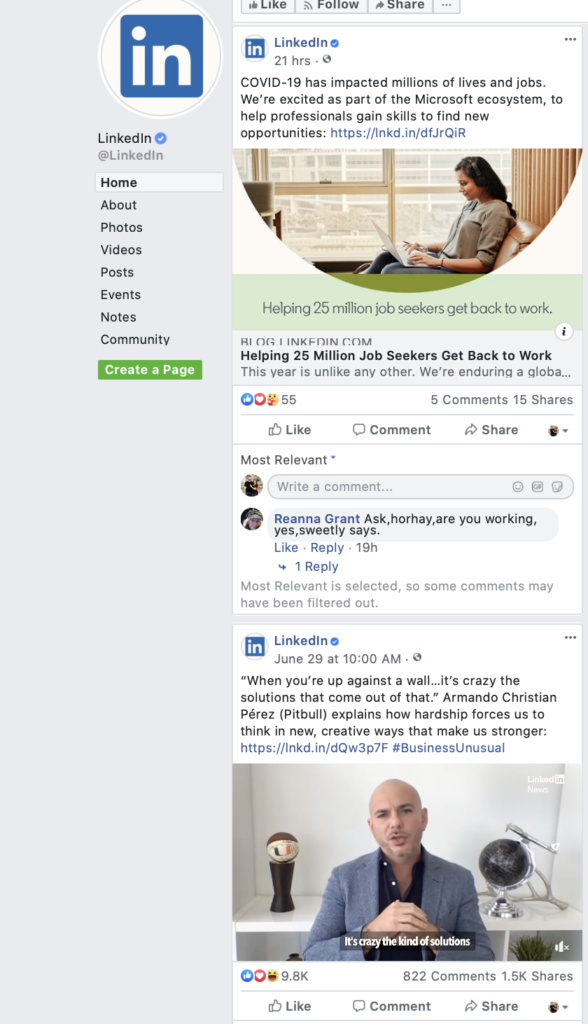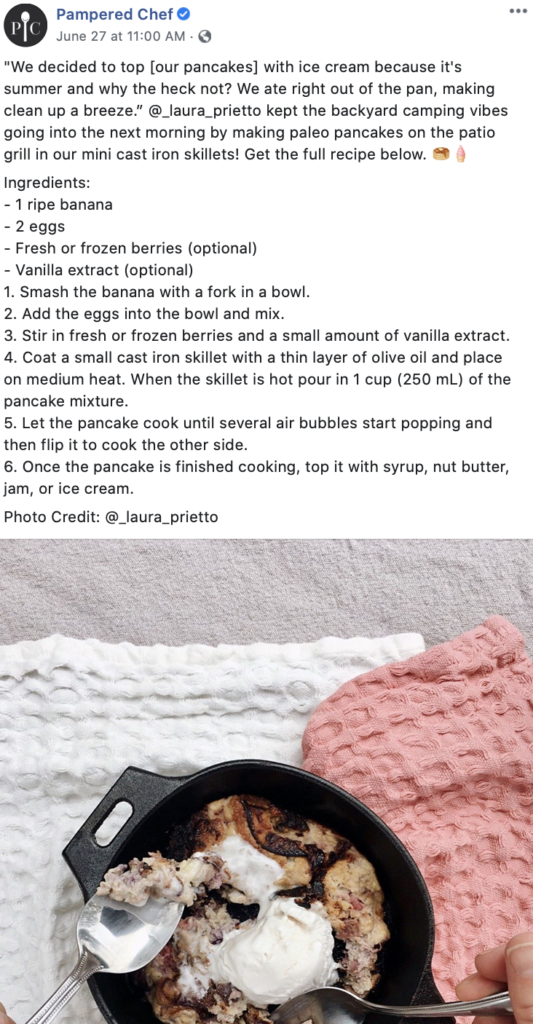Most brands that I’ve worked with that taken a fly-by-the-seat-of-their-pants approach to their social calendar. They post when they remember to, and they’re always kind of scrambling to figure something out a little last minute.
They rely heavily on blog posts to fill their social feed, but that’s not the greatest strategy.
Platforms like Instagram don’t even allow you to add links to your content outside of your Stories, and platforms like Facebook don’t give priority to outbound links.
Instead of opting for a last-minute or day-before approach to creating your social media content, it’s actually much more beneficial to create a balanced social media calendar in advance.
By doing this, you can ensure that you’re properly optimizing for all of your goals on social, you can increase the quality and diversity of your content, and you can have more well-rounded profiles that appeal to larger percentages of your target audience.
It’s easier to actually be strategic when you’re not scrambling at the last minute, and strategic means you can get more results.
Fortunately, it’s actually typically much easier to create a balanced social calendar in advance when you know exactly how to do so and you have the right tools to help.
In this post, we’re going to go through 8 simple steps that you should take to create a strong, strategic, and balanced social media calendar that will drive results.
Review or Create Your Social Strategy
First, before you do anything at all, you’re going to want to take a look at your existing social strategy.
All businesses, brands, and organizations should have a clear social media strategy that’s created based on the specific goals that they have. It might look something like this:
- Use social media to increase discovery using growth and visibility-boosting tactics like using location-based hashtags, boosting high-performing posts, and creating social contests.
- Nurture relationships with leads and followers, using tactics like offering valuable resources through video content, infographics, and insider tips.
- Driving sales by offering access to “exclusive” discounts, offers, or sales on social media 1x per month.
- Fostering a feeling of exclusivity by creating closed groups for your brand, particularly on Facebook, and by offering behind-the-scenes content.
Writing down your social strategy gives you focus, ensuring that you’re prioritizing everything you need to.
Take time to either review your current strategy or, if needed, to create a new one.
This only takes a few hours at the absolute max, and you can always hire social media consultants to put this together for you even if you want to tackle your own social content creation.
Get Started With a Social Management & Publication Tool
We know a lot of people like to opt for free or native tools whenever possible, and we absolutely get that. Trust us when we say, though, that using high-quality social media management and publishing tools is the way to go here.
It makes it easier for you to map out a full month or more worth of content across multiple platforms. These tools also have additional features like engagement management options, team working capabilities, in-depth analytics, and more.
AdEspresso’s Experts Secret Tool: Hootsuite
For obvious reasons (two of them being that we use it and we love it), we strongly recommend Hootsuite.
You can easily upload posts for multiple platforms at one time, reschedule them as needed, and even send them to clients or managers for approval if you’re working for a client or under a superior. You can images, videos, and text-based posts in the blink of an eye.
You can see a little more about exactly how it works here:
Whatever tool you choose, make sure that it will scale well, that it’s versatile, and that it makes it easy for you to create, schedule, and reschedule content as needed.
In my experience, it’s common to end up moving around content that’s already on the calendar as you’re fleshing out the month and when last-minute events pop up.
Plan a Month In Advance
We know that this is a bizarre year where nothing really makes sense, but in general, we’ve got more stability and it’s absolutely possible to plan your content calendar a month out in advance. It’s possible now, too, you just may need to offer more updates to customers along the way as you go.
We strongly recommend sitting down at the beginning of each month (or, even better, slightly before it) to create the basis of your content calendar for the next thirty or so days.
Note that this does not mean that you can’t change it or that you can’t add to it, but having a solid stream of great content lined up to keep your audience engaged in a way that’s addressing as many of your goals as possible.
This takes some of the pressure off during the month, and when you’re planning everything out all at once, it makes it much easier to intentionally create a balanced calendar that your audience will love.
This also gives you plenty of time to find stock photos, create graphics, edit or shoot videos, and even strategize great content in advance, including shooting plenty of images and videos for your Stories.
You also have plenty of time to get the content approved if needed by other team members or clients.
Plug your planned content into your social media publishing tool so you can see everything laid out, and make adjustments as needed.
Create Special Event & Priority Content First
As you’re fleshing out your content calendar, there’s going to be some content that you’ll want to create and schedule first.
We call this your “priority content,” because it should get first dibs on your calendar to announce, promote, and facilitate it.
The following may all be included in priority content for your business:
- Big, time-sensitive announcements like breaking the news on a new product or sharing updates about safety precautions during COVID
- In-store or online events that you want to drive traffic to, which can include webinars and online flash sales
- Facebook events, contests, or Live Q&As.
For most priority content, you’ll likely want to post about it more than once.
You should be promoting an in-store event at least once per week minimum for several weeks leading up to the said event, for example.
You’ll also want to post about a Facebook or Instagram live around a day or so in advance, letting people put it on their schedules and ask questions in advance they’d like you to answer, and then to post again a few hours before.
Because this content is most important, you want it to go on the calendar first. The timing needs to be right. Everything else can be built around it.
Create Queues of Strong Evergreen Content
Creating a library of strong, evergreen content that aligns with your goals is always an excellent call.
Saving this content into your social media managing tool so that you’re essentially creating queues of ready-to-go, already-uploaded content to fill in any gaps in the schedule is a huge advantage, and it’s an easy secret to a balanced social calendar.
Be Always Ready with Hootsuite’s AutoSchedule
I once worked with a client who had an extraordinary amount of UGC, and a major part of our social strategy was centered around sharing and leveraging that content.
We didn’t always know exactly when UGC would come in, though, so I would use Hootsuite’s AutoSchedule feature to help with this.
I’d set up a library of evergreen posts to get us through the month of beyond, and if no new UGC posts came up, I’d leave lots slots empty for auto-content to fill. If something did come up, I’d just remove the slot.
Hootsuite’s AutoSchedule tool allows you to create a vast store of already-approved, ready to go content that will fill any gaps in your social schedule.
If you’re not sure where to start, all of the following make great evergreen content for your queue:
- Recaps of popular blog posts and links out.
- Infographics based on research your brand as conducted, even if it’s been shared on your blog or site already.
- Engagement-oriented content, like those asking users what they want to see you write about or what their summer plans are.
- Promotion of resources that you’ve already shared in the past but that are still relevant now.
- General product promotions to keep your audience engaged and brand awareness up.
Use At Least Three Types of Media Each Month
If you want a balanced and high-engaging social media portfolio, then you need a diverse social media calendar. And there’s no easier way to do this than switching up your post types, both in terms of subject and media.
A lot of brands stick exclusively to sharing plain-text posts with occasional images because it’s easy and convenient. By doing this, however, you’re robbing yourself of the opportunity to connect more significantly with your followers and keeping them engaged.
Having fresh, different content will grab their attention and can keep them around longer.
If you’re not sure where to start, the following can all count as different types of media for these purposes:
- Plain-text posts (though these should be used least frequently, even on platforms that allow it)
- Images including photographers and graphics
- Gifs
- Video
- 3-D images
- Live broadcasts
Add in Insider & Industry Tips to Create Value
It’s important to include some valuable resources every month.
Nobody comes to your Facebook or Instagram just for a sales pitch, even if they want to check out your brand and product. Creating valuable, interesting, relevant content that our audience can benefit from is a great way to increase engagement (which can increase your reach and visibility on multiple platforms) while nurturing a relationship.
Depending on your business, try to add at least four value-oriented posts per month.
Many service-based businesses will likely benefit from sharing more than this, including marketing firms, realtors, tutors, and lawn service companies.
For eCommerce companies, this can include sharing tips to increase the usefulness of their product.
Someone selling a pasta maker, for example, can show videos for how to use it, clean it, and care for it, along with posting an abundance of recipes. They might also have a video for troubleshooting, like why your pasta keeps falling apart or what’s causing it to be too sticky.
A lawn service company might create value-oriented content like videos detailing how to properly maintain gardens during summer weather, a list of the most-durable landscaping plants that require minimum cost or effort to maintain, or an explanation for why fertilizing your lawn is supposedly so important.
These updates can be timely, like a mortgage broker explaining why the current interest rates are so beneficial for refinancing right now. The more relevant they are, the better.
Customize Content for Each Platform
Each platform has unique quirks, usage, and best practices. While it’s easy to just set a single post to publish in the exact same way on every platform, this isn’t always best.
Instead, it’s best to keep in mind this:
- You can add up to 10 images on Instagram in one of their multi-slide images, but can only upload one image per pin on Pinterest.
- You can have long, rambling posts on Facebook (whether or not that’s a good idea is another story), but are limited to 280 characters on Twitter.
- You should use hashtags on both Twitter and Instagram, but only two or three at the absolute max on Twitter and you can use up to 30 on Instagram.
- You should customize your content for each individual platform. You can use social scheduling software to help with duplicating an existing Facebook post, editing it, and then publishing it to Instagram, or any other platform.
This will help you see results and drive engagement on each individual platform, strengthening your results as a whole.
Final Thoughts
Social media marketing may seem easy at a first glance, especially since so many of us are using multiple platforms on a daily basis.
It’s essential, however, that your social calendar is just as strategic and carefully planned-out as your blog, your email list, and any other marketing messaging that you’re releasing.
It’s often the first touchpoint for many potential customers, so you want to make a good impression and keep them engaged.
What do you think? Which social media management tools do you use? How do you create a cohesive, balanced social media content calendar that works for your brand? How does strategy play into it? Share your thoughts and questions in the comments below!






These are some very interesting tips to create a perfect social calendar. When it comes to social media, I believe that working in an organized way and putting effort consistently is the key thing.
Unbelievably easy steps and helpful tips! Great blog!